Lake Mburo National Park is located in the western part of Uganda in a district called Kirihura which is next to Mbarara district. It sits on an area covering 260 sq km hence making it the smallest Savannah park in Uganda. Lake Mburo is the center of activities in the park but there are 11 other lakes around the area. There is a local Ankole myth and legend about two brothers Kigarama and Mburo once lived in a big valley around the park. Kigarama had a revelation in a dream that warned of a danger that would befall them if they continued staying in the valley. He shared his dream with Mburo who didn’t believe him. Kigarama moved to safety on the hills away from the valley. One day the valley got flooded with water that eventually drowned Mburo. The lake was named Mburo and the nearby hills Kigarama.
Although the park is small in size compares to 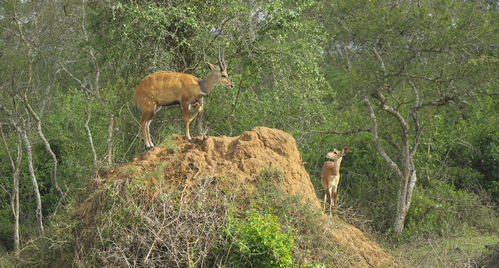 the others, it has stunning landscape that consists of flat grasslands, rolling hills, forests, bush thickets, rocky outcrops, Lakes and swamps. The elimination of elephants in the park has led to the growth of vast woodlands in the park. Lake Mburo has some wildlife species rarely found in other parks of Uganda. Some of the species include the Eland, Klipspringer, Impala, Zebra (5,000 in number) and giant bush rats. Lake Mburo national park is the best place to spot Leopards in Uganda because of their high numbers per square kilometer.
the others, it has stunning landscape that consists of flat grasslands, rolling hills, forests, bush thickets, rocky outcrops, Lakes and swamps. The elimination of elephants in the park has led to the growth of vast woodlands in the park. Lake Mburo has some wildlife species rarely found in other parks of Uganda. Some of the species include the Eland, Klipspringer, Impala, Zebra (5,000 in number) and giant bush rats. Lake Mburo national park is the best place to spot Leopards in Uganda because of their high numbers per square kilometer.
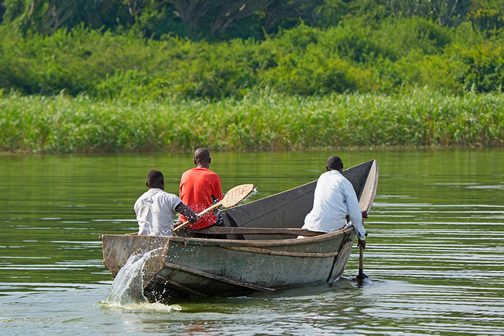 Lake Mburo National Park lies in the rain shadow between the Rwenzori Mountains and Lake Victoria giving it an average rainfall of 798 mm per year. It is located conveniently along a highway that links the capital city Kampala to the other major national parks and tourism hot spots like Queen Elizabeth National Park and Lake Bunyonyi in the western part of Uganda. This strategic location makes it appealing to tourists who wish to make stopovers during the long drives to see gorillas in Bwindi or Chimpanzees in Kibale Forest Park. The close proximity to Kampala makes it the most easily accessible game park for someone desiring to see Uganda’s wildlife after a seminar or conference in the capital.
Lake Mburo National Park lies in the rain shadow between the Rwenzori Mountains and Lake Victoria giving it an average rainfall of 798 mm per year. It is located conveniently along a highway that links the capital city Kampala to the other major national parks and tourism hot spots like Queen Elizabeth National Park and Lake Bunyonyi in the western part of Uganda. This strategic location makes it appealing to tourists who wish to make stopovers during the long drives to see gorillas in Bwindi or Chimpanzees in Kibale Forest Park. The close proximity to Kampala makes it the most easily accessible game park for someone desiring to see Uganda’s wildlife after a seminar or conference in the capital.
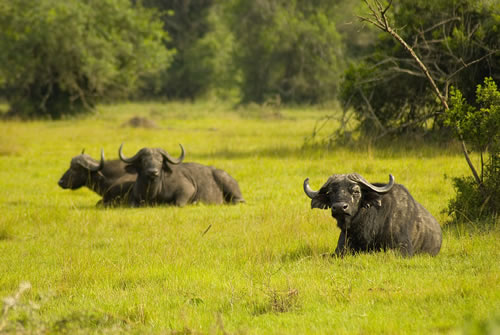 Lake Mburo National Park has had a turbulent past that led to the near total elimination of wildlife through poaching and encroachment by the local tribes in the surrounding area. The park started as a controlled hunting area in 1933 before it was turned into a game reserve in 1963. In 1983, the reserve was upgraded into a game park with an intention of removing away the local Banyankole pastoralists who were accused of supporting government rebels (Led by the current president Yoweri Kaguta Museveni) opposed to the regime of Milton Obote. Once the Obote regime fell, the pastoralists raided the park and
Lake Mburo National Park has had a turbulent past that led to the near total elimination of wildlife through poaching and encroachment by the local tribes in the surrounding area. The park started as a controlled hunting area in 1933 before it was turned into a game reserve in 1963. In 1983, the reserve was upgraded into a game park with an intention of removing away the local Banyankole pastoralists who were accused of supporting government rebels (Led by the current president Yoweri Kaguta Museveni) opposed to the regime of Milton Obote. Once the Obote regime fell, the pastoralists raided the park and 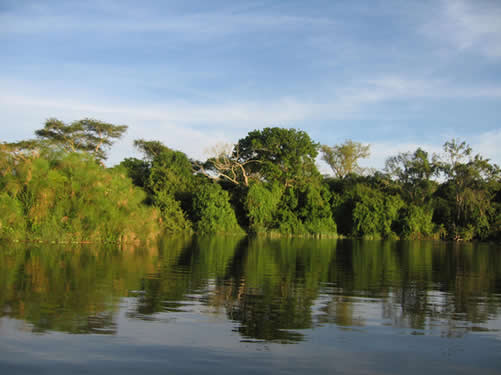 reoccupied it after chasing away the park staff. The park never regained its former size because the new government could only reclaim half of the park land for fear of hurting the locals.
reoccupied it after chasing away the park staff. The park never regained its former size because the new government could only reclaim half of the park land for fear of hurting the locals.
Things have changed now and the Uganda Wildlife Authority works closely with the local tribes living around the park to help protect the animals in the park. Lake Mburo National Park has now become an example of how human communities around the park can co-exist with wildlife in Uganda. The collaboration between the government authority and locals has not only led to the successful reintroduction of lions, but also giraffe, eland, baboons and other wildlife. The park is a Lion Conservation unit.
Attractions in Lake Mburo National Park
Visitors to the park have plenty of choices when it comes to activities as you will learn from our 3 Days Wildlife Safari in Lake Mburo National Park package. Besides lions the park has got animals like buffalo, eland, hippos, impala, jackals, leopards, oribi, reedbuck, topi, warthog, waterbucks, zebras and the recently reintroduced giraffes from Murchison Falls National Park. One is required to pay an entrance fee to enter the park. 20% of the fee is channeled to funding nearby community projects (clinics, schools and buildings). The main activities in Lake Mburo are game drives (night and day), walking safaris/nature walks, sport fishing, horseback riding, boat trips and birding among others. A tour operator can help advise you on how best to spend your time at the park and go about with booking each of the following activities:-
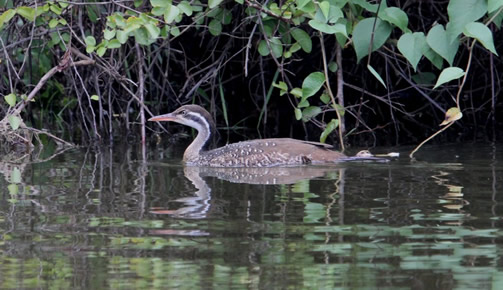 Birdwatching: Lake Mburo is one of the best places for birding in Uganda. Birding in Lake Mburo is mainly done along the swamps of Warukiri and Miriti. Some of the species include the African grey hornbill, barefaced go-way bird, black-billed barbet, blue-napped mousebird, brown parrot, common quails, crested francolin, emerald spotted wood Dove, greenwood hoopoe, Lilac-breasted Roller, Nubian woodpecker, Rednecked Spur, trilling cisticola, white-winged warbler and the Shoebill stork. While at the Rwonyo camp, birders can also spot the African-wattled plover Rufous, Black Bellied Bustard, Coqui francolin, Flappet larks, red-necked spur fowl, Rufuos chested Swallow, southern Red Bishop, temminck’s courser and yellow-throated long claw. Lake Mburo is a great place to spot the rare white backed heron and African finfoot.
Birdwatching: Lake Mburo is one of the best places for birding in Uganda. Birding in Lake Mburo is mainly done along the swamps of Warukiri and Miriti. Some of the species include the African grey hornbill, barefaced go-way bird, black-billed barbet, blue-napped mousebird, brown parrot, common quails, crested francolin, emerald spotted wood Dove, greenwood hoopoe, Lilac-breasted Roller, Nubian woodpecker, Rednecked Spur, trilling cisticola, white-winged warbler and the Shoebill stork. While at the Rwonyo camp, birders can also spot the African-wattled plover Rufous, Black Bellied Bustard, Coqui francolin, Flappet larks, red-necked spur fowl, Rufuos chested Swallow, southern Red Bishop, temminck’s courser and yellow-throated long claw. Lake Mburo is a great place to spot the rare white backed heron and African finfoot.
Guided Nature Walks: Unlike in the other park in Uganda, nature walks can be taken in any part of the park under the arrangement and guidance of an armed guard from the Uganda Wildlife Authority. While on the nature walk you will get to see the various antelopes, Zebras, buffaloes and giraffes grazing. Watch out for the butterflies and birds too. During the morning walks, you might even encounter hyenas going to their dens after the nights hunt or hippos heading to the water after grazing on land.
The Lakeside Track: Related to the nature walk is the walk through the established Lakeside Track in the southern part of Lake Mburo. This track allows visitors spot bush duiker and marvel at the dense woodland. The track leads up to the Kigarama summit which allows for great views of Lake Mburo and the greater national park.
Fishing: The numerous lakes and spots like Mazinga offer opportunities for fishing species like the Tilapia, Haplochromes, mud fish, lung fish and mud fish. Mazinga fishing spot is located in a safe section of Lake Mburo with no crocodiles or hippos. Visitors can take part in sport fishing and arrange for someone to help fry the fish back in their lodge. There are shades near the fishing pints that ensure relaxation in-between fishing session. Mission Africa Safaris can help arrange gear (hooks and bait) and acquire fishing licenses for travelers before they arrive for their safari.
Day and Night Game Drives: Game drives in Lake Mburo National park allow you to spot most of the parks animal and birds that call the park home. The game drives are led by an armed ranger from the Uganda Wild Life Authority (UWA) who helps identify the different species of animal and birds. The “leopard rock” is a popular place to spot leopards during the night safari or early in the morning. Hyenas exist in the park but are not as many as in some of the other major game parks in Uganda. The night game drives take 2 hours and are perfect for spotting genet, leopards, bush pigs, mongooses and white tailed mongooses.
Boat Cruise: A boat cruise along the Lake Mburo will help unlock all that is beautiful about the Park. This is more so during the dry season when most of the animals come for a drink. During the boat cruise visitors can spot zebras, antelopes, crocodiles, hippos, otters and buffaloes. The commonest birds during the boat cruise include African Fish Eagles, Blue-headed Weavers, Cormorants, Green-necked Doves, Hammerkops, Herons, Malachite Kingfishers, Pelicans, Pied Kingfishers, Rufous Long-tailed Starlings and Shoebill Storks. The duration of the boat cruise is not fixed and is open to negotiation.
Rubanga Forest Walk: The forest walk is usually arranged by the Uganda Wild Life Authority in advance and starts from Western shores of Lake Mburo. Rubanga forest is a great place for birding and over 42 species can be spotted during the forest walk. Some of the tree species to look out for while in Rubanga forest are Acacia, Fig Trees, Markhamia, Palm and Platycaluz among others. The bird species include the double-toothed barbet, green pigeon, Grey-backed cameroptera, harrier hawk, narina trogn and the much sought out Shoebill Stork.
The Salt Lick: An armed ranger can lead you for the guided walk to the Salt lick where animals lick the salty soil found in the area. Observation points have been identified by the Uganda Wildlife Authority to allow visitors view all the different species of animals that come to lick the salt like zebras and antelopes. The activity usually starts in the morning and takes at most two hours.
Horseback Riding: Lake Mburo is one of the two parks in Uganda where visitors can go out to watch game from the back of a horse. Kabwoya wildlife reserve along Lake Albert is the other place where horse riding safaris can be done in Uganda. Horseback safaris allow visitors get very close to the animals. The horses appear familiar to the Zebras and even shy Eland. Though they still keep their distance, they do not run away like they do in the presence of safari cars.
Visiting the Igongo Cultural Center: The Igongo cultural Center is located 4 kilometers away from the Sanga gate. The Banyakitara use the Center to showcase their cultural heritage and traditions. The Banyakitara tribes include the Bakiga, Banyoro, Batooro and Banyankole. There is a small museum where local art crafts and items related to their ancient cultural traditions are kept. Visitors have an opportunity to learn about the history and way of life of the tribes with the help of guides. The traditional huts made of grass and local food are all on show among many other items. Visitors can buy souvenirs like locally made crafts and other art pieces.
Walking Safaris: Visitors who arrive by public means can opt for a walking safari around places like the Kazuma Hill. A walking safari will enrich your experience in Uganda and offer something unique and different. The Kazuma Hil offers a perfect place to spot the beautiful spots in the park ranging from the 14 Lakes, rolling hills and surrounding areas of the park. Walking alone in the park is prohibited especially because the park has buffaloes and lions. Threats can also come from hyenas and hippos that go to graze outside the Lakes at night.
Quad Biking to spot Game: Because there are few big cats,biking is one of the best ways to spot game in Lake Mburo National Park. The Quad bike rides take you in the middle of grazing zebra and surrounding areas to spot the local Banyankole tribe graze their long horned Ankole cattle. Quad Biking safaris are special because they take you nearer to nature. Visitors need to pack water and snack while on their Quad biking safari in case of hunger and exhaustion.
Note: Although tourism activities are carried out throughout the year, the best time to visit Lake Mburo National Park is during the dry season. The roads in the park become muddy and difficult to pass through during the rainy season.
How to reach Lake Mburo National Park
Since Lake Mburo National Park is located between Mbarara and Kampala, it can be accessed from both places. From Kampala City, it takes about 4 hours of driving to reach the park headquarters. At about 211 km from Kampala on the Kampala-Mbarara highway, there is a signpost on the left pointing to the Nshara gate of the park.
If one is coming from the side of Mbarara, it takes only 47km of driving to reach the park headquarters. The park signpost indicating a right turn can be seen when you reach Sanga. From Sanga, the distance is 12 Kilometers to the Rweshsbeshebe Gate of the park. The road from Sanga to the park gate is not built with tarmac and can prove difficult to pass during the rainy season without a good four wheel drive car. Regardless of which direction visitors are planning to use, public vehicles only stop at the main highway. One will need to wait for a little while to get a vehicle from the main road to the main gate.
Accommodation in Lake Mburo National Park
Like in the other parks, accommodation facilities (lodges, hotels, campsites) in Lake Mburo are divided into 3 main categories – Budget, mid-range and Luxury. Accommodation is available within the game park and in nearby towns like Mbarara and Lyantonde. There are 3 public campsites at the Rwonyo park headquarters as well as luxury hotels like the Manatana Luxury tented camp and Mihingo Lodge which we shall discuss in more detail in the following paragraphs:
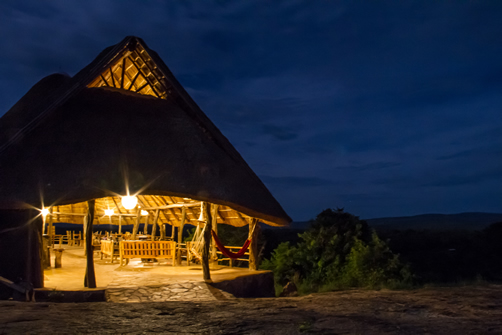 Mantana tented camp: This luxury camp has been in the park for many years offering consistent and reliable services that keep clients coming. There are 9 tents that are built on wooden platforms with wonderful views of the game park. The camp use solar and rooms are furnished with showers. It is possible to spot the lakes and wildlife as they roam about the park while dining or relaxing in the room verandahs. Talking dining, the dishes are both local and international. There is a sitting area, a bar and restaurant where one can order for cold drinks in the evenings.
Mantana tented camp: This luxury camp has been in the park for many years offering consistent and reliable services that keep clients coming. There are 9 tents that are built on wooden platforms with wonderful views of the game park. The camp use solar and rooms are furnished with showers. It is possible to spot the lakes and wildlife as they roam about the park while dining or relaxing in the room verandahs. Talking dining, the dishes are both local and international. There is a sitting area, a bar and restaurant where one can order for cold drinks in the evenings.
The Arcadia Cottages: This mid-range lodge is part of the Arcadia group of lodges and is located close to the shores of Lake Mburo. The lodge offers a serene and peaceful environment that is perfect for relaxation. Because it is located very near Rwonyo (tourism center of the park), it is a good choice for those intending on going for game drives, boat cruises and nature walks. Some of the services and facilities include a restaurant, bar and open fires. The hotel has both self-contained rooms and cottages with double beds, WiFi and television.
Rwonyo Rest Camp: Rwonyo Rest camp is a budget lodge located in the park and is managed by the Uganda Wildlife Authority (UWA). The lodge is grass thatched and constructed with wood and other local. Visitors can see some of the wild animals that come near the camp while in the lodge. The lodge has both bandas and tented rooms that are built on raised platforms of wood. The bandanas are cheaper and have shared showers while the tented rooms have private showers. Visitors are who come with their own tents are given space in which to erect them.
Lake Mburo Safari Lodge: This is yet another great budget lodge that offers great value and privacy while allowing residents marvel at the African wilderness. This lodge is a favorite of many visitors because of the moderate prices for rooms. The lodge offers both family and honeymoon grass thatched cottages. The rooms are self-contained and furnished with locally designed furniture, wardrobes, king sized beds, mosquito nets, showers and bath tubs. The honeymoon cottage has a kitchen, fridge and a coffee maker. The deck offers great relaxation in-between activities in the park. Meals and drinks are served at the main bar and the restaurant which also caters for vegetarians.
Eagle’s Nest Lodge: This budget lodge is built on a hill near Lake Mburo Park. The hill gives you an excellent view of most of the park. You can hear bush sounds, roaring lions, crickets and other night animals while having dinner. The lodge has 12 tents with thatched roof and stone floors. The tents are furnished with private showers, Eco-toilets and a verandah where you can view the animals in the morning and late afternoon. There is a bar and a restaurant but meals can be served in the rooms.
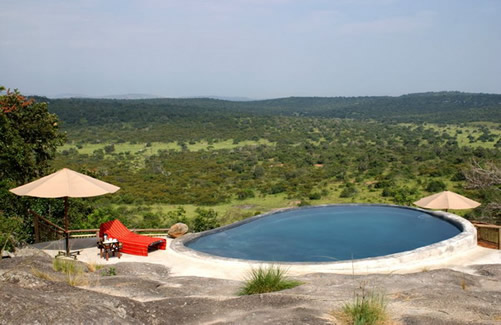 Mihingo Lodge: Mihingo lodge is a luxury lodge that was built in 2007 by a group of Germans. The 10 tented rooms are built with local materials and stand on wooden platforms that are covered with neat grass. The rooms are furnished with private bathrooms, hot showers and a verandah. There is also a swimming pool and tennis court. Baby sitting and children’s food can be arranged for visitors with infants. The lodge arranges horseback tours outside the national park in the valleys around Lake Kacheera. There are 4 ponies and 7 horses available for use. To avoid crowding, only 6 people may take part in each session.
Mihingo Lodge: Mihingo lodge is a luxury lodge that was built in 2007 by a group of Germans. The 10 tented rooms are built with local materials and stand on wooden platforms that are covered with neat grass. The rooms are furnished with private bathrooms, hot showers and a verandah. There is also a swimming pool and tennis court. Baby sitting and children’s food can be arranged for visitors with infants. The lodge arranges horseback tours outside the national park in the valleys around Lake Kacheera. There are 4 ponies and 7 horses available for use. To avoid crowding, only 6 people may take part in each session.
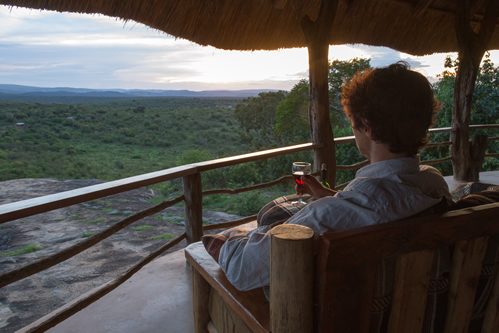 Rwakobo Rock: The Rwakobo Rock is a mid-range family hotel built at the edge of the park. The hotel is Eco-friendly with 9 cottages that are suitable for private retreats while offering great views of the mountains and animals (bushbucks, warthogs, impala and zebras) assembling to drink at the water hole. The cottages have solar heated showers, solar lights, WiFi and charging facilities. The restaurant prepares both local and international dishes with special treats for vegetarians. The bar is stocked with both soft and alcoholic drinks (wines, local beer and spirits). Teetotalers can opt for coffee, tea or drinking water. There are charging facilities and WiFi in the main hotel area.
Rwakobo Rock: The Rwakobo Rock is a mid-range family hotel built at the edge of the park. The hotel is Eco-friendly with 9 cottages that are suitable for private retreats while offering great views of the mountains and animals (bushbucks, warthogs, impala and zebras) assembling to drink at the water hole. The cottages have solar heated showers, solar lights, WiFi and charging facilities. The restaurant prepares both local and international dishes with special treats for vegetarians. The bar is stocked with both soft and alcoholic drinks (wines, local beer and spirits). Teetotalers can opt for coffee, tea or drinking water. There are charging facilities and WiFi in the main hotel area.

